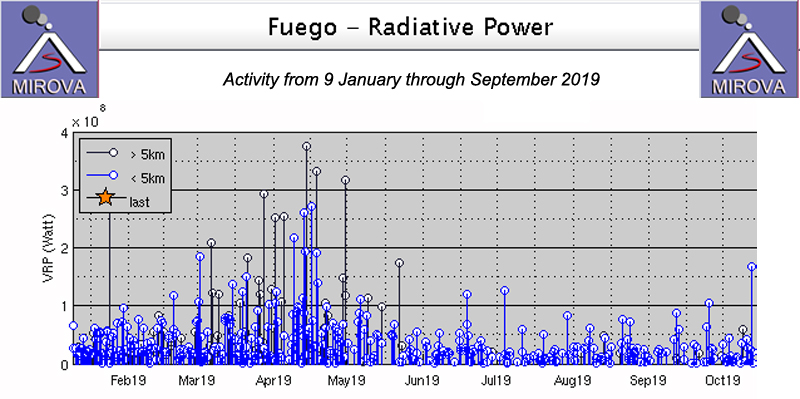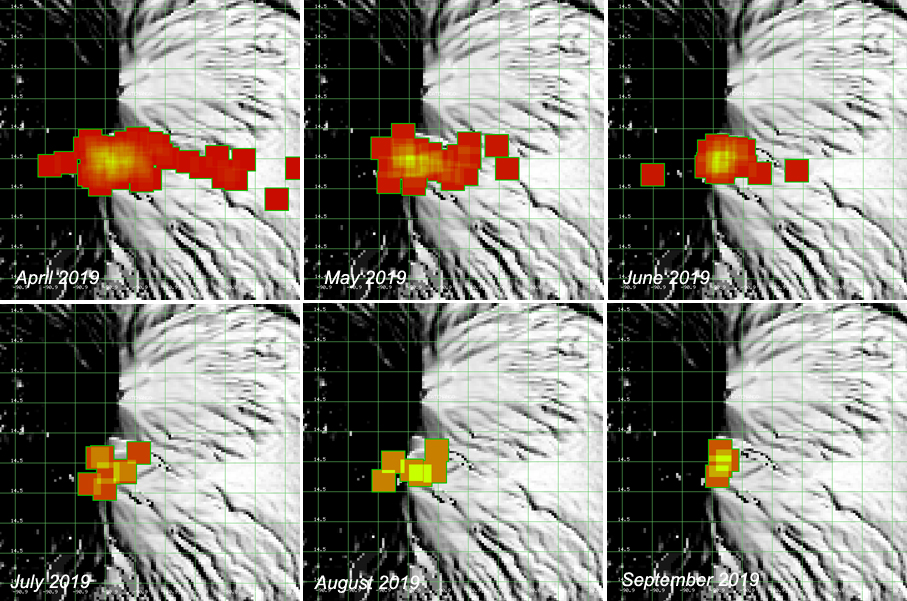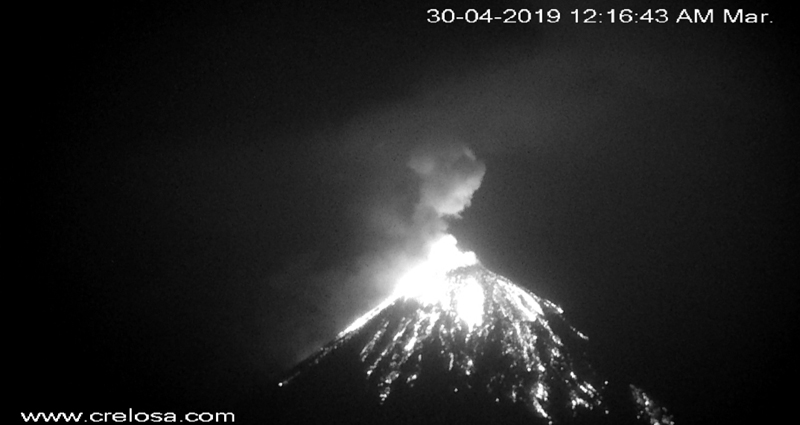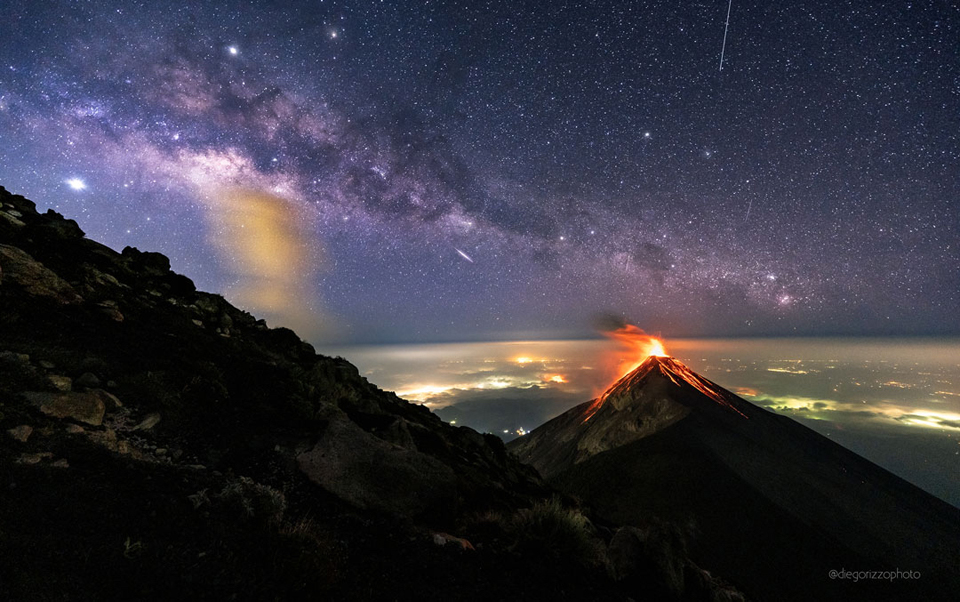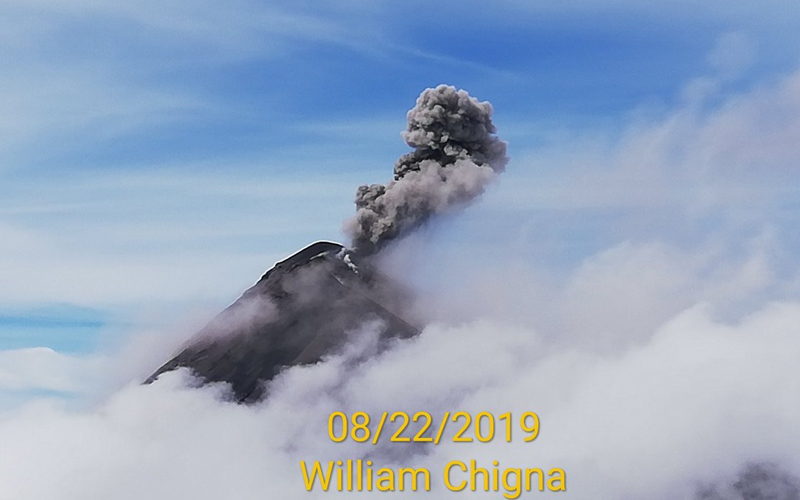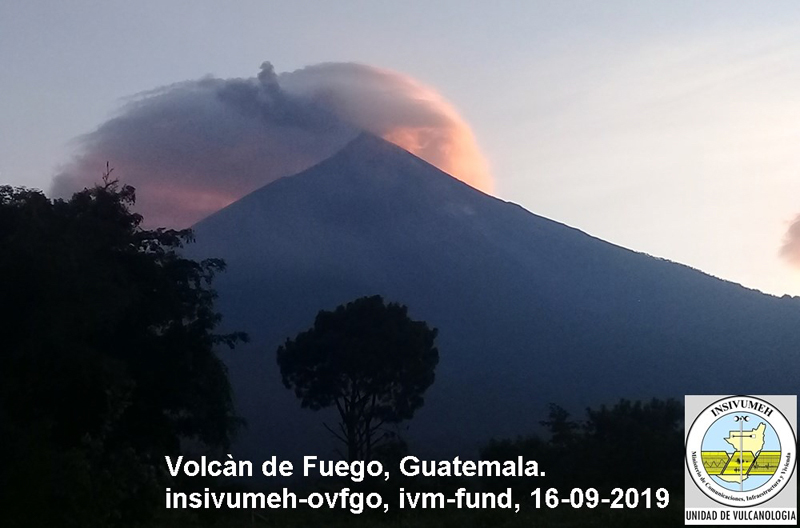Report on Fuego (Guatemala) — October 2019
Bulletin of the Global Volcanism Network, vol. 44, no. 10 (October 2019)
Managing Editor: Edward Venzke.
Edited by A. Elizabeth Crafford.
Fuego (Guatemala) Ongoing ash plume explosions and block avalanches, April-September 2019
Please cite this report as:
Global Volcanism Program, 2019. Report on Fuego (Guatemala) (Crafford, A.E., and Venzke, E., eds.). Bulletin of the Global Volcanism Network, 44:10. Smithsonian Institution. https://doi.org/10.5479/si.GVP.BGVN201910-342090
Fuego
Guatemala
14.4748°N, 90.8806°W; summit elev. 3799 m
All times are local (unless otherwise noted)
Guatemala's Volcán de Fuego was continuously active through September 2019; it has been erupting vigorously since 2002 with historical observations of eruptions dating back to 1531. These eruptions have resulted in major ashfalls, pyroclastic flows, lava flows, and damaging lahars. Large explosions with hundreds of fatalities occurred during 3-5 June 2018; after a brief pause, significant activity resumed and continued during April-September 2019, the period covered in this report. Reports are provided by the Instituto Nacional de Sismologia, Vulcanología, Meteorología e Hidrologia (INSIVUMEH) and the National Office of Disaster Management (CONRED); aviation alerts of ash plumes are issued by the Washington Volcanic Ash Advisory Center (VAAC). Satellite data from NASA and other sources provide valuable information about heat flow and gas emissions.
Daily activity continued at a high level throughout April-September 2019 (table 19) with multiple ash explosions every hour, incandescent ejecta reaching hundreds of meters above the summit sending block avalanches down multiple ravines, and ash falling on communities on the SW flank and beyond. During April and part of May a lava flow was also active in the Seca ravine. Although explosive activity remained at a high level throughout the period, thermal activity began a decline in May that continued through September, noticeable in both the MIROVA radiative power data (figure 117), and monthly images of MODVOLC thermal alerts (figure 118).
Table 19. Activity summary by month for Fuego with information compiled from INSIVUMEH daily reports.
| Month | Fumarole Color, Height (m), Direction | Ash Explosions per hour | Ash Plume Heights (km) | Ash Plume Distance (km) and Direction | Incandescent Ejecta Height (m) | Ravines affected by avalanche blocks | Sounds and Vibrations | Villages Reporting ashfall | Lava Flow activity |
| Apr 2019 | Gray and White, 4,100-4,500, W-SW | 10-25 | 4.3-5.0 | 10-25, W-SW-E-N | 100-450 | Seca, Taniluyá, Ceniza, Trinidad, Las Lajas and Honda | Weak to moderate rumbles, shock waves rattled roofs, train engine noises every 5-20 minutes | Panimaché I and II, Morelia, Santa Sofía, El Porvenir, Los Yucales, Finca Palo Verde, Sangre de Cristo, San Pedro Yepocapa, La Rochela, Ceilán, El Rodeo, Alotenango, Ciudad Vieja, Osuna | Active flow in Seca ravine, 200-800 m long |
| May 2019 | Gray and White, 4,200-4,500, W-SW-S | 12-26 | 4.5-4.9 | 10-30, W-SW-S-SE | 200-450 | Seca, Taniluyá, Ceniza, Trinidad, El Jute, Las Lajas and Honda | Weak to moderate rumbles, shock waves rattled roofs, train engine noises at regular intervals | Panimaché I and II, Morelia, Santa Sofía, El Porvenir, Los Yucales, Finca Palo Verde, Sangre de Cristo, San Pedro Yepocapa, Ceilán, La Rochela | Active flow in Seca ravine, 300-1,000 m |
| Jun 2019 | White, 4,100-4,500, E-SE-N-W-SW | 10-24 | 4.4-4.8 | 10-30, W-SW-NW-N-E-SE | 200-450 | Seca, Taniluyá, Ceniza, Trinidad, El Jute, Las Lajas and Honda | Weak to moderate rumbles, shock waves rattled roofs, train engine noises every 5-10 minutes | Sangre de Cristo, Yepocapa, Morelia, Santa Sofía, Panimache I and II, El Porvenir, Finca Palo Verde, La Rochela, Ceilán, Alotenango, San Miguel Dueñas | -- |
| Jul 2019 | White, 4,100-4,500, W-SW | 8-25 | 4.3-4.8 | 10-25, W-SW | 150-450 | Seca, Taniluyá, Ceniza, Trinidad, El Jute, Las Lajas and Honda | Weak to moderate rumbles, shock waves rattled roofs, train engine noises every 5-15 minutes | Morelia, Santa Sofía, El Porvenir, Finca Palo Verde, San Pedro Yepocapa, Panimaché I y II, Sangre de Cristo, La Rochela, Ceilán | -- |
| Aug 2019 | White, 4,100-4,500, W-SW | 10-23 | 4.4-4.8 | 10-25 W-SW | 200-400 | Seca, Taniluyá, Ceniza, Trinidad, El Jute, Las Lajas y Honda | Weak to moderate rumbles, shock waves rattle windows; train engine noises every 3-13 minutes | Morelia, Santa Sofía, El Porvenir, Finca Palo Verde, San Pedro Yepocapa, Panimaché I y II, Sangre de Cristo, and others | Flow in Seca ravine, 13 Aug 75-100 m |
| Sep 2019 | White, 4,100-4,400, W-SW | 5-22 | 4.4-4.8 | 10-20 W-SW | 200-400 | Seca, Taniluyá, Ceniza, Trinidad, El Jute, Las Lajas and Honda | Weak to moderate rumbles, shock waves rattled roofs, train engine noises every 3-10 minutes | Panimaché I, Panimache II villages,Morelia, Santa Sofía, Palo Verde estate, San Pedro Yepocapa, Sangre de Cristo, El Porvenir, La Rochela villages and Ceylon | -- |
Activity increased at the very end of March 2019. The rate of explosions increased to 14-32 events per hour by 31 March; ash plumes rose to 5 km altitude and resulted in ashfall in numerous nearby communities. An early morning lava flow that day reached 800 m down the Seca ravine. Continuous white and gray fumarolic plumes reached 4.1 to 4.4 km altitude during April 2019 and drifted generally W and SW. There were about 15-20 ash-bearing explosions per hour; the highest rate of 25 per hour occurred on 10 April. Plume altitudes were below 4.8 km for most of the month; on 28 and 29 April they rose to 5.0 and 4.9 km. For most of the month they drifted W and SW; the wind direction changed to the E during 10-16 April. Most days of the month ashfall was reported in the communities of Panimaché I y II, Morelia, Santa Sofía, Finca Palo Verde, San Pedro Yepocapa, Sangre de Cristo and El Porvenir on the W and SW flank. During 10-13 April when the wind direction changed to easterly, communities to the NE, E and SE of Alotenango, Ciudad Vieja, La Reunión, La Rochela, El Rodeo, Osuna, Ceilán and others on the N and E flanks were affected by ashfall. The Washington VAAC issued multiple daily advisories on 18 days in April, identifying short-lived ash plumes drifting with the prevailing winds.
Incandescent ejecta rose 200-300 m above the summit on most days (figure 119). During 23-25 April, ejecta rose 300-450 m above the summit. Six ravines were affected by the incandescent avalanche blocks nearly every day: the Seca, Taniluyá, Ceniza, Trinidad, Las Lajas, and Honda. The explosions caused rumbles, shock waves that rattled roofs, and sounds similar to a train locomotive at intervals of 5-20 minutes in nearby communities throughout the month. A lava flow was present in the Seca (Santa Teresa) ravine for most of the month; its length varied from 200 to 800 m. Special reports of lahars were issued seven times during April. On 4 April a moderate lahar descended the Seca ravine carrying centimeter- to meter-sized blocks, tree trunks and branches. During 9-11 April nine lahars were recorded in the Las Lajas, El Jute, Seca, Rio Mineral, Taniluya, and Ceniza ravines. The largest flows were 20 m wide and 3 m deep carrying blocks and debris up to 3 m in diameter; they were warm and thick with a strong sulfurous odor. Two more lahars were reported on 18 April in the Taniluya and Ceniza ravines carrying 1-2 m sized blocks in a warm, sulfurous flow.
During May 2019, primarily white fumaroles rose to 4.2-4.5 km altitude and drifted W, SW, and S; gray fumaroles were reported only during the first few days of the month. Generally, 15-20 ash explosions per hour occurred; the maximum was 26 on 17 May. Ash plume heights ranged from 4.5-4.8 km altitude nearly every day, drifting 10-25 km primarily W, SW, and S throughout the month, except for 6-8 May when plumes drifted NW and 18-19 May when wind directions changed and sent ash S and SE. Plumes drifted 25-30 km SE, S, and SW on 19 May. Ashfall was reported daily from communities on the W flank including Panimaché I and II, Morelia, Santa Sofía, El Porvenir, Los Yucales, Finca Palo Verde, Sangre de Cristo, and San Pedro Yepocapa, among others, and also from the E side including Ceilán and La Rochela when the wind direction changed. The Washington VAAC issued multiple daily ash advisories on 19 days during May.
Incandescent Strombolian activity continued sending ejecta 200-300 m above the summit during the first half of the month and 300-450 m high during the latter half (figure 120). Seven major ravines, the Seca, Taniluyá, Ceniza, Trinidad, El Jute, Las Lajas, and Honda were affected by block avalanches throughout the month. Intermittent explosions caused rumbles, shock waves that rattled roofs, and sounds similar to a train locomotive at frequent intervals on most days. The lava flow in the Seca ravine advanced from 300 m length on 2 May to 1,000 m long on 9 May. It was reported as being 500 m long on 18 May but was not active after that date. Numerous lahars descended multiple ravines in May. INSIVUMEH issued nine special reports of lahar activity on 3, 14, 16, 20, 23, and 27-29 May. They affected the Las Lajas, Ceniza, El Jute, El Mineral, and Seca ravines. The thick, pasty flows contained blocks of various sizes up to 3 m in diameter along with tree trunks and branches. Several were warm with a sulfurous smell (figure 121). SO2 emissions remained low throughout April-September with only minor emissions recorded in satellite data on 1 April and 9 May 2019 (figure 122).
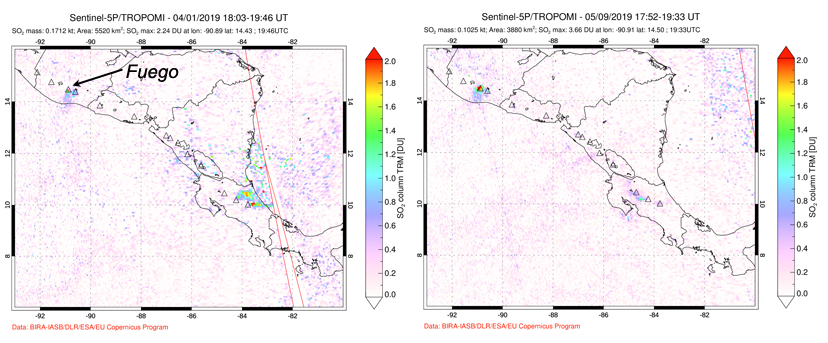 |
Figure 122. Weak SO2 emissions were recorded from Fuego on 1 April and 9 May 2019 by the TROPOMI instrument on the Sentinel 5P satellite. Courtesy of NASA Goddard Space Flight Center. |
The fumarolic plumes were only white during June 2019, rising to 4.1-4.5 km altitude daily, drifting W or SW except during the first days of the month when variable winds sent the steam N, E, and SE. Explosions with ash took place 15-20 times per hour on most days with plumes rising to 4.5-4.8 km altitude and drifting primarily W or SW except for the first days of the month (figure 123). On most days, ash plumes drifted 15-20 km W and SW, except during 2-7 June when winds sent ash E, SE, N, and NW. Ashfall was reported virtually every day in Sangre de Cristo, Yepocapa, Morelia, Santa Sofía, and Panimache I and II. In addition, the communities of El Porvenir, Los Yucales, and Finca Palo Verde reported ashfall several days each week. During 2, 4, and 7 June, the N and SE winds caused ash to fall in Alotenango and San Miguel Dueñas. The Washington VAAC issued ash advisories on 15 days during June.
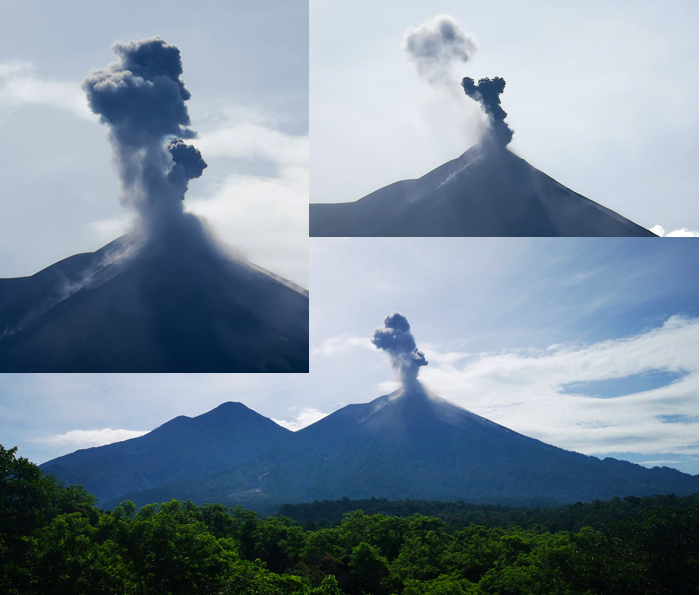 |
Figure 123. Emissions of both steam and ash rose from Fuego on 11 June 2019. Courtesy of Paul A. Wallace, University of Liverpool. |
The height of the Strombolian ejecta varied from 200-300 m above the summit on many days in June , but also was sometimes stronger, rising 300-450 m. While block avalanches were reported in all seven barrancas (ravines) more than once (Seca, Taniluyá, Ceniza, Trinidad, El Jute, Las Lajas and Honda), on all days they were reported in the Seca, Taniluya, Ceniza, and Trinidad. Weak to moderate rumbles and shock waves rattled roofs every day, and train engine noises were heard every 5-10 minutes. Seven special reports of lahars were issued on days 2, 11, 21-23, and 30. They affected the Las Lajas, El Jute, Seca, El Mineral, and Ceniza ravines with thick, pasty flows containing blocks 1-3 m in size, shaking the ground as they flowed downstream.
During July 2019, white steam plumes rose daily from the summit of Fuego to an altitude of 4.1-4.3 km and drifted W and SW; higher plumes on 30 and 31 July rose to 4.5 km altitude. Fifteen to twenty ash explosions per hour were typical throughout the month and produced ash plumes that rose to 4.3-4.8 km altitude and drifted SW and W for 10-25 km before dissipating (figure 124). Near-daily ashfall was reported in Morelia, Santa Sofía, El Porvenir, Finca Palo Verde, San Pedro Yepocapa, Panimaché I y II, and Sangre de Cristo; La Rochela and Ceilán also reported ash on 4 and 6 July. Incandescent ejecta height varied from 150-450 m above the summit from day to day, sending block avalanches down all seven ravines on many days. Weak to moderate rumbles and shock waves rattled roofs every day, and train engine noises were heard every 5-15 minutes. On 19 July noises and vibrations were heard and felt 25 km away. Only one lahar was reported on 12 July in the Las Lajas ravine. It was warm, with a sulfurous odor, and carried volcanic ash, sand, and blocks 1-3 m in diameter that shook the ground as they flowed downstream. The Washington VAAC issued ash advisories on 13 days during July.
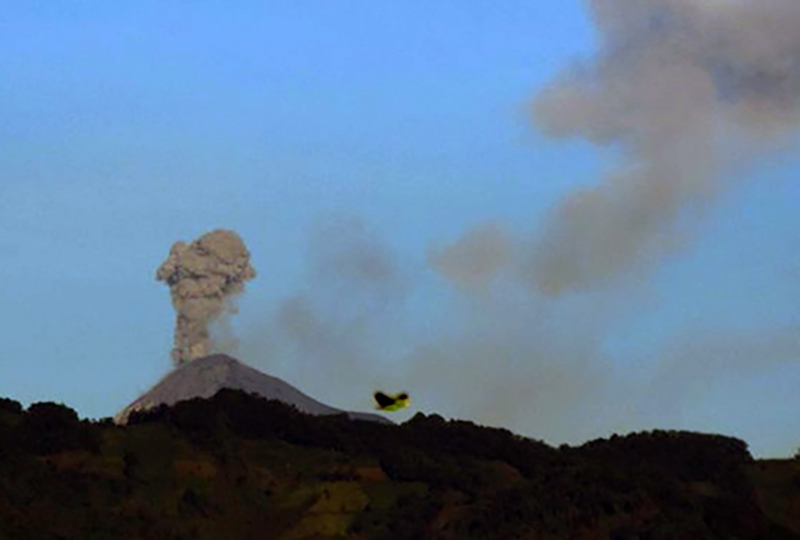 |
Figure 124. Steam-and-ash plumes rose from Fuego on 12 July 2019 in this image taken at dawn from Villa Flores San Miguel Petapa. Courtesy of Alex Cruz (cropped and color adjusted from original). |
White steam plumes continued during August 2019, rising to an altitude of 4.1-4.5 km and drifting W and SW daily. Ash-bearing explosions continued also at a rate of about 15-20 per hour throughout the month, rising most days to between 4.5 and 4.7 km altitude. They drifted 15-20 km W or SW nearly every day before dissipating. Every day during the month, ashfall was reported in Morelia, Santa Sofía, El Porvenir, Finca Palo Verde, San Pedro Yepocapa, Panimaché I y II, Sangre de Cristo, and other communities on the SW flank. The Washington VAAC reported ash plumes at Fuego on 15 days during August (figure 125).
Incandescent ejecta also rose every day during August 2019 to 200-300 m above the summit, a few days were reported to 350-400 m. Every day, block avalanches descended the Seca, Taniluyá, Ceniza, and Trinidad ravines; most days blocks also traveled down the Las Lajas and Honda ravines, and many days they were also reported in the El Jute ravine (figure 126). Every 5-10 minutes, every day, weak and moderate rumbles sounding like a train engine shook buildings and rattled roofs in the nearby villages. On 13 August a small lava flow, 75-100 m long, was reported in the Seca ravine. Six lahars were reported on 3 August. They occurred in the Santa Teresa, Mineral, Ceniza, El Jute, and Las Lajas ravines. The thick pasty flows carried blocks 1-2 m in diameter, tree trunks and branches, and disrupted the roads between Siquinala and San Andres Osuna and El rodeo and El Zapote. The next day two more occurred in the Seca and Mineral drainages. From 17-20 August, six more lahars occurred, most in the Las Lajas drainage, but also in the Seca, Mineral and Ceniza ravines.
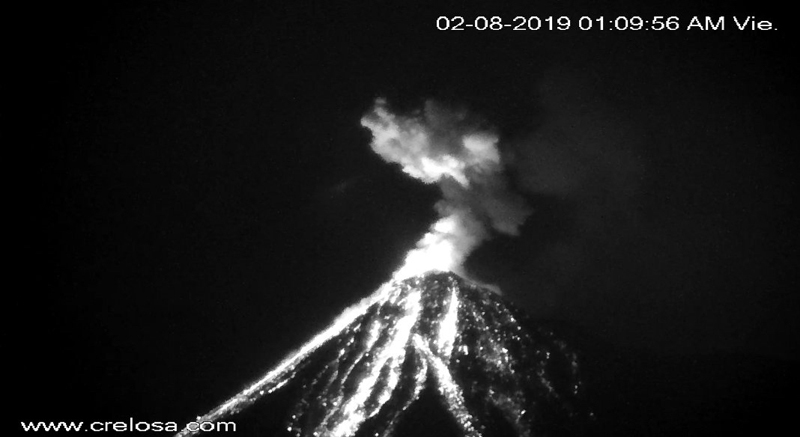 |
Figure 126. Incandescent blocks traveled down several ravines at Fuego on 2 August 2019. Courtesy of Publinews Guatamala. |
There were no changes in the steam fumaroles during September 2019; plumes seldom rose over 4.3 km altitude and continued drifting W and SW. The ash explosion rate decreased somewhat and rates of 5-10 per hour were typical on many days. Ash plume heights remained constant around 4.5-4.7 km altitude most days, also drifting W and SW 15-20 km before dissipating (figure 127). While ashfall was reported daily in Panimaché I, Morelia, Santa Sofía, Porvenir, Palo Verde, Yepocapa and other communities on the SW flank for the first half of the month, it grew more intermittent during the second half of September. South-directed winds deposited ash on La Rochela villages and Ceylon on 25 September. The Washington VAAC issued aviation ash advisories on 11 days during the month. Strombolian ejecta mostly rose 200-300 m above the summit; occasionally it reached 300-400 m. On most days, block avalanches descended the Seca, Taniluyá, Ceniza, Trinidad, and Las Lajas ravines; occasionally they were reported in the El Jute and Honda ravines as well. Every day, rumbles and shock waves shook roofs in nearby villages every 5-10 minutes. Lahars were reported twice, on 2 ad 9 September, in the Seca and Rio Mineral drainages both days, dragging branches, tree trunks and blocks up to 2 m in diameter.
Geological Summary. Volcán Fuego, one of Central America's most active volcanoes, is also one of three large stratovolcanoes overlooking Guatemala's former capital, Antigua. The scarp of an older edifice, Meseta, lies between Fuego and Acatenango to the north. Construction of Meseta dates back to about 230,000 years and continued until the late Pleistocene or early Holocene. Collapse of Meseta may have produced the massive Escuintla debris-avalanche deposit, which extends about 50 km onto the Pacific coastal plain. Growth of the modern Fuego volcano followed, continuing the southward migration of volcanism that began at the mostly andesitic Acatenango. Eruptions at Fuego have become more mafic with time, and most historical activity has produced basaltic rocks. Frequent vigorous eruptions have been recorded since the onset of the Spanish era in 1524, and have produced major ashfalls, along with occasional pyroclastic flows and lava flows.
Information Contacts: Instituto Nacional de Sismologia, Vulcanologia, Meteorologia e Hydrologia (INSIVUMEH), Unit of Volcanology, Geologic Department of Investigation and Services, 7a Av. 14-57, Zona 13, Guatemala City, Guatemala (URL: http://www.insivumeh.gob.gt/ ); MIROVA (Middle InfraRed Observation of Volcanic Activity), a collaborative project between the Universities of Turin and Florence (Italy) supported by the Centre for Volcanic Risk of the Italian Civil Protection Department (URL: http://www.mirovaweb.it/); Hawai'i Institute of Geophysics and Planetology (HIGP) - MODVOLC Thermal Alerts System, School of Ocean and Earth Science and Technology (SOEST), Univ. of Hawai'i, 2525 Correa Road, Honolulu, HI 96822, USA (URL: http://modis.higp.hawaii.edu/); Coordinadora Nacional para la Reducción de Desastres (CONRED), Av. Hincapié 21-72, Zona 13, Guatemala City, Guatemala (URL: http://conred.gob.gt/www/index.php); NASA Astronomy Picture of the day (URL: https://apod.nasa.gov/apod/ap190527.html); Global Sulfur Dioxide Monitoring Page, Atmospheric Chemistry and Dynamics Laboratory, NASA Goddard Space Flight Center (NASA/GSFC), 8800 Greenbelt Road, Goddard, Maryland, USA (URL: https://so2.gsfc.nasa.gov/); Paul A. Wallace, Lecturer in Geology, University of Liverpool, Liverpool England (URL: https://www.liverpool.ac.uk/environmental-sciences/staff/paul-wallace/, Twitter: @Paul_A_Wallace, URL: https://twitter.com/Paul_A_Wallace/status/1138527752963993600); Alex Cruz, Photojournalist, Guatemala (Twitter: @ACruz_elP, URL: https://twitter.com/ACruz_elP/status/1149690904023691264/photo/1); William Chigna, Guatemala (Twitter: @William_Chigna, URL: https://twitter.com/William_Chigna/status/1164575009966370816); Publinews Guatemala, (Twitter: @PublinewsGT, URL: https://twitter.com/PublinewsGT/status/1157288917365903360).


